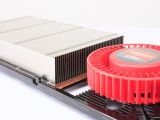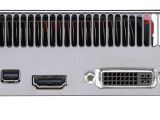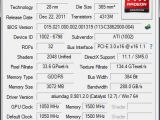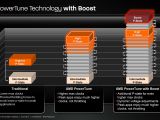It's been quite a long time since AMD managed to beat Nvidia twice using the same GPU generation. Usually, the former Canadian GPU designer used to beat its main competitor by releasing a new architecture faster than Nvidia was able to finish theirs.
Today, the Texas-based GPU and CPU designer AMD officially launched the company’s new flagship gaming video card.
It is called Radeon HD 7970 GHz edition and just like the name implies, it runs at 1000 MHz, or simply put, 1 GHz.
Many were hoping for a new GPU revision and some special/wonder PCB, but (unfortunately) that’s not the case.
We said “unfortunately” and used the Brackets because the situation has both good and bad sides.
The good side – and we must congratulate AMD for that –, is that the company managed to squeeze a 8.1% higher base clock and a 9% higher memory clock using exactly the same technology as they did on the initial Radeon HD 7970.
Then AMD added some rather interesting software modifications to their PowerTune utility. The GHz edition uses a finer grain of GPU frequency adjustments than the one used on the initial Radeon HD 7970.
There is also the fact that AMD ups or lowers the GOU frequency 10 times faster than Nvidia does with their GTX 680 Kepler-based video cards.
The power limit remained the same at 250 watts, but AMD even managed to add a “Boost clock” option to their automatic overclocking software.
So, besides the higher default GPU clock of 1000 MHz, AMD’s Radeon HD 7970 GHz Edition will actually run at 1050 GHz when GPU utilization is over 90%.
That’s a 13.5% GPU frequency improvement over what the initial HD 7970 was able to do.
All these frequency increases come at a lower launch price than the original Radeon HD 7970, as the GHz Edition is officially priced at $499.
That’s €395, and it is right on par with Nvidia’s GTX 680.
AMD was not able to charge a price premium, as the card only equals GTX 680 in performance terms, while the Radeon HD 7970 was clearly superior to the GTX 580 back in the day.
Now comes the bitter part of that “unfortunately” that we mentioned earlier.
The GHz Edition comes with higher noise and higher temps than both the original HD 7970 and the GTX 680.
This is clearly because AMD did not do any physical changes to the card’s architecture, but it only modified the BIOS and clocking/monitoring software.
We would have like a newer and better cooling system at least. AMD could have touted improved thermals and lower noise generation.
That’s clearly not the case.
As both Nvidia and AMD released new drivers this week, the combination between the new beta drivers and the faster card actually makes AMD stand on equal grounds with Nvidia’s Kepler when it comes to gaming on a single monitor.
On multi-monitor setups, we must agree that AMD has an edge due to its 50% greater amount of onboard memory.
When taking on GPU compute, AMD’s GCN architecture clearly spanks Nvidia’s Kepler and the GHz Edition only adds insult to injury.
Nvidia needs specific CUDA application to equal AMD’s GCN performance, and even then we’re not sure if the Californian GPU designer is able to hold its own.
It’s quite amazing that AMD managed to beat Nvidia exactly at the GPU compute chapter, since Nvidia has been working for years to maintain its lead and CUDA has been very popular.
Therefore, if you want the best gaming performance and superior GPU compute performance and don’t mind the extra noise, you can safely bet on AMD’s new Radeon HD 7970 GHz.
There is also a higher than average chance that a non-optimized game will run better on AMD’s 7000 series cards than on Nvidia’s CUDA-dependent Kepler.
On the other hand, if silence is important for you and you don’t really care about GPU compute, multi-monitor performance and Nvidia-neutral games, the GeForce GTX 680 is the better choice.
We must congratulate AMD for their achievement. As modest at it would be, AMD managed to beat Nvidia twice using the same GPU revision.
Now we're eagerly awaiting the company’s dual-GPU Radeon HD 7990 solution.
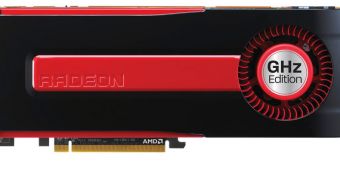
 14 DAY TRIAL //
14 DAY TRIAL // 
